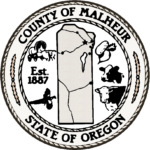Cow Hollow Park is situated in rural Malheur County, Oregon near the city of Nyssa. The address of the Park is 1030 Janeta Avenue, Nyssa. The Park is 20 acres and includes twenty- one (21) RV sites with electricity, playground equipment, cement restroom facility with bathrooms and showers, tennis court with basketball hoop, baseball/softball fields and a horseshoe pit.
After the attack on Pearl Harbor, CCC
Camp BR-43 was turned over to the Farm Security Administration and the area
became known as the Nyssa Japanese-American Interment Camp. The Amalgamated
Sugar Company and state officials convinced President Franklin D. Roosevelt to
allow an evacuation exception, providing Japanese internees the choice of
working in Malheur County in order to solve an acute agricultural labor shortage
in Malheur County. In early May 1942, several hundred Japanese families moved
to the FSA camp. The Amalgamated Sugar Company, which owned a sugar beet factory
in Nyssa, paid their wages and living expenses.
“Movement of evacuees into the sugar beet field started on May 20, 1942, when a small contingent of 15 recruits from the Portland Assembly Center arrived on farm lands controlled by the Amalgamated Sugar Company near Nyssa, Oregon. The movement of evacuees to the beet fields continued during May and June, slacked off slightly in midsummer and then resumed in preparation for the fall harvest. Altogether, approximately 10,000 evacuees left War Relocation Authority centers during 1942 for seasonal work primarily in Idaho, Utah, Montana, Colorado and eastern Oregon. By conservative estimates, the evacuees probably saved enough beets to make nearly 250,000,000 pounds of sugar.” Source: U.S. Department of Interior, War Relocation Authority, Story of Human Conservation pp. 31-32.
Irrigation District requested the Bureau of Reclamation to turn Cow Hollow Park
over to it for the purpose of providing for recreation in the area and other
purposes. From the 1960s to the 1990s the North Board of Control entered into
a formal lease agreement with the Cow Hollow Park and Recreation Association for
administration of Cow Hollow Park. At that time, baseball diamonds, a tennis
court and undeveloped camp-sites were developed.
In 2004, Cow Hollow Park became the responsibility of the Bureau of Land Management (BLM) when the Secretary of Interior revoked the Park’s status as “withdrawn” federal public domain land. The BLM, however, determined the land be unsuitable to return to the public domain. Cow Hollow Park was declared surplus Government property and available for disposal.
